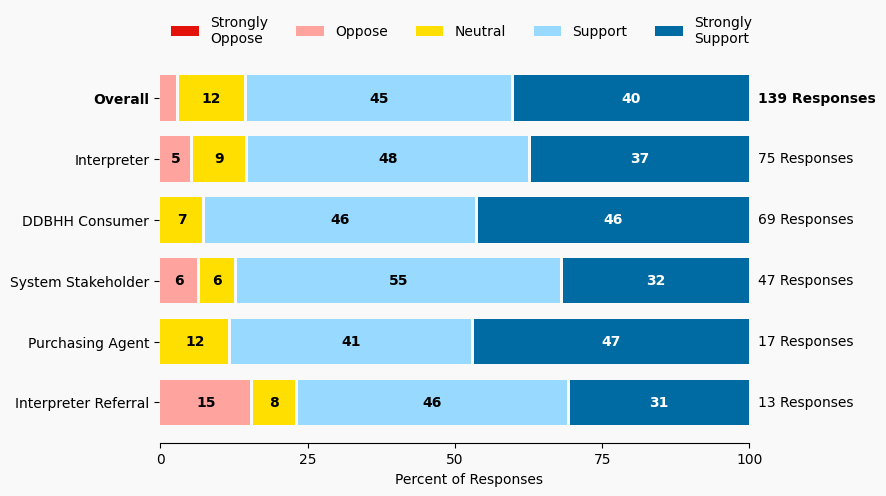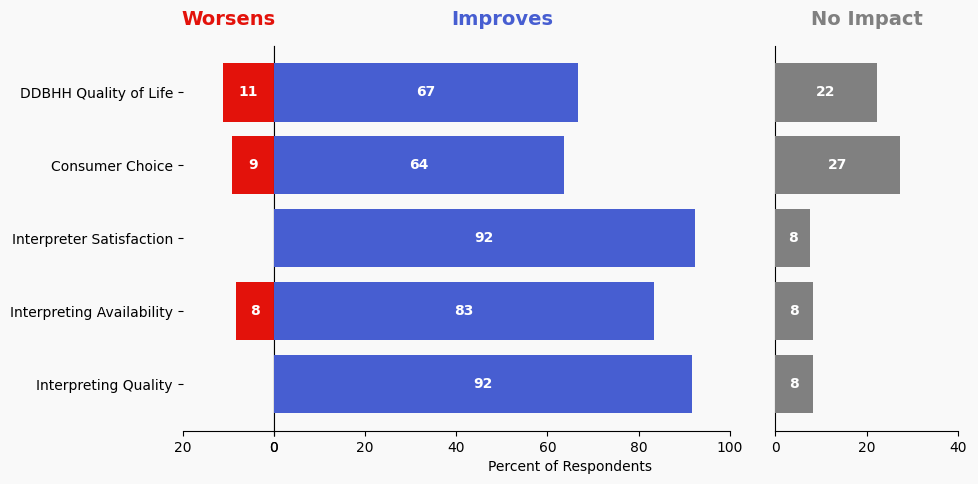32 Provide Co-Navigating and Other Workshops to Interpreters
Issue: DeafBlind individuals express concerns about specific skill sets that very few interpreters are able to demonstrate.
Proposed Solution: DeafBlind grant awardee(s), interpreter referral companies, MRID or other entity provide specific training regarding: Ambidexterity Co-navigating oral interpreting (for those who are hard of hearing) how to approach regular check-ins with consumers on what their communication needs are (as needs may change over time) and other topics requested by DeafBlind consumers.
Expected outcome: Interpreters develop stronger skill sets in DeafBlind interpreting; DeafBlind consumers receive better interpreting services.
Who is impacted: Interpreters, DeafBlind consumers
Update: This solution is being incorporated to #51.
Timeline: 6 months

Summary of Support Image Description
The stacked bar charts show how respondents rated their level of support and the total number of responses. The percentage for the five support levels is shown from left to right: Strongly Oppose (Dark Red), Oppose (Light Red), Neutral (Yellow), Support (Light Blue), and Strongly Support (Dark Blue).
Respondents may identify with multiple subgroups. The overall level of support is:
Overall
Strongly Oppose: 0%
Oppose: 3%
Neutral: 12%
Support: 45%
Strongly Support: 40%
Click to see the detailed image description for each subgroup.
Interpreter
Strongly Oppose: 0%
Oppose: 5%
Neutral: 9%
Support: 48%
Strongly Support: 37%
Purchasing Agent
Strongly Oppose: 0%
Oppose: 0%
Neutral: 12%
Support: 41%
Strongly Support: 47%
DDBHH Consumer
Strongly Oppose: 0%
Oppose: 0%
Neutral: 7%
Support: 46%
Strongly Support: 46%
Interpreter Referral
Strongly Oppose: 0%
Oppose: 15%
Neutral: 8%
Support: 46%
Strongly Support: 31%
System Stakeholder
Strongly Oppose: 0%
Oppose: 6%
Neutral: 6%
Support: 55%
Strongly Support: 32%
Overview of Respondents Opting for In-Depth Solution Analysis
After indicating their support level, 8% of the 139 respondents opted in to further assess whether the solution would worsen or improve on five metrics. Of the opt-in reviewers (12 respondents), 91% supported the solution, 8% were neutral on the solution, and 0% opposed the solution.
The remaining 127 respondents did not opt in to further assess the solution. Of these people, 85% support the solution, 11% were neutral on the solution, and 3% opposed the solution.
Reviewer Evaluation of Solution Effectiveness

Solution Effectiveness Image Description
The stacked bar charts show how respondents assessed the effectiveness of this solution based on five metrics. For each metric, the percentage of respondents is shown from left to right: Worsens (Red), Improves (Blue), No Impact (Gray).
DDBHH Quality of Life
Makes It Worse 11%
Makes It Better 66%
No Impact 22%
Interpreter Satisfaction
Makes It Worse 0%
Makes It Better 92%
No Impact 7%
Consumer Choice
Makes It Worse 9%
Makes It Better 63%
No Impact 27%
Interpreting Availability
Makes It Worse 8%
Makes It Better 83%
No Impact 8%
Interpreting Quality
Makes It Worse 0%
Makes It Better 91%
No Impact 8%
Reviewer Feedback and Insights
Interpreter
Comments from Interpreters suggest that hiring entities should offer more flexible employment options to meet the diverse needs of interpreters. Concerns include ensuring that interpreters have access to a variety of employment opportunities. Suggestions include creating a system that allows interpreters to choose the type of employment that best suits their needs.
Deaf, DeafBlind, Hard of Hearing
Comments from DDBHH Consumers express support for providing more employment options for interpreters, with concerns about ensuring that the options are accessible to all interpreters. Suggestions include creating a system that allows interpreters to work in a variety of settings. Concerns focus on ensuring that the employment options promote inclusivity and accessibility.
System Stakeholder
Comments from System stakeholders suggest that providing more employment options for interpreters could help improve access to interpreting services. Suggestions include creating a system that allows interpreters to choose the type of employment that best suits their needs. Concerns include ensuring that the employment options are fair and accessible to all interpreters.
PREVIOUS SOLUTION
31 Interpreter Referral Companies Establish and Maintain Self-Reporting to the Public
Issue: As private businesses that serve a business and social demand for communication services, information about services is generally not shared. There is a lack of knowledge about the scope of services, issue areas and fill rates.
NEXT SOLUTION
33 Legislate Requiring Consumer Grievance Process for Referral Companies
Issue: DDBHH consumers often feel that concerns or complaints about interpreters are not addressed.
Leave a Reply